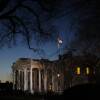As last week began, Washington D.C. felt a little like a city under tsunami alert. People—primarily, but by no means exclusively Democrats—fretted that Donald Trump’s administration would be a wrecking force, that could only be watched powerlessly as it swept through.
By the end of the weekend, the tide seemed to have shifted dramatically. Now momentum seemed to move with a wave of opposition, against a surprisingly wobbly-legged administration.
The shift might signal a long-term energy of resistance; or just demonstrate how quickly the winds will shift, back and forth, during the coming weeks, months, and years.
The lead-up
At mid-week, the streets of Washington were relatively quiet. Other than the occasional overheard pro-Trump conversation, and a few anti-Trump flyers taped on light poles, there was little evidence of strong emotion from either side.
Official, public Washington—party leaders, elected officials, and news media—were focused primarily on the types of disputes typical of any party-changing presidential transition: a stock-purchase allegation about one Cabinet appointee, attempts to delay a vote on another, and wailing about the proposed policy changes outlined by the rest.
Behind the scenes, concern was building about the struggling pace of the Trump transition. This goes far beyond several delayed hearings and votes for cabinet secretary choices. Trump has named only 28 of 690 “key executive branch nominations” being tracked by the Partnership for Public Service—ranging from director of the U.S. Mint to Secretary of the Navy—which are only the most important of some 1,200 appointments requiring Senate confirmation, and more than 4,000 overall.
The importance of this, at least for now, lies less in the short-term ability of the government to operate, than in the long-term morale of the civil servants who actually run everything. As one appointee of both George W. Bush and Obama told me, most civil servants just want protection for their pension, and a manager for their office who isn’t an ogre. Budget-cutting rhetoric from Trump and congressional Republicans have workers concerned about the former; lack of appointees has them worried about the latter.
All of these things are important, but seemed increasingly out-of-sync with Americans back home, urging their representatives to boycott the inauguration of a man many saw as a genuine, unique threat to their rights, safety, and sense of belonging in their own country.
At the same time, both the fears of Trump opponents, and the hope of his core supporters, were starting to give way to the realities of Washington. Odds dimmed of an immediate end to the Affordable Care Act, Deferred Action for Childhood Arrivals (DACA), and the North American Free Trade Agreement (NAFTA). Even before he took office, Trumpism was looking less and less like an unstoppable force.
Inauguration day
As Friday morning progressed, reports increasingly suggested a relatively light turnout. As images and estimates circulated in social networks and media reports, comparisons with Obama’s massive 2009 crowd were inevitable, and the stark difference served to remind many of the excitement that accompanied Obama’s entrance to that office.
Before Friday, many assumed a similar enthusiasm behind Trump. He is, after all, a populist champion—a Jacksonian figure finally reclaiming the government from the elite oppressors and for the great mass of the citizenry. Large, energetic crowds had flocked to his rallies.
Certainly it was unlikely that Trump could equal the estimated 1.8 million who packed the mall in 2009. Obama’s historic nature, and the heavy Washington-area concentration of Democrats—African-Americans in particular—made direct comparisons unfair. Still, official organizations, including Trump’s own inauguration committee, were preparing for between 700,000 and a million attendees.
That populist joy failed to materialize. The estimated 250,000 was not only far, far below the first inaugurations of Democrats Obama and Bill Clinton, but short of even the roughly 300,000 who came for George W. Bush in 2001 and George H.W. Bush in 1989.
Nor was there any sense of mass ground-level celebration outside of Washington, out in cities and towns across the country. In short, those worrying that Trumpism represents, or has unleashed, a massive and fearsome American force, saw a surprising lack of evidence for it.
But if those Trump skeptics were hoping for him to reach out to them in his speech, they were disappointed.
Trump’s inaugural speech carried forward the dystopian vision from his campaign, and barely gave lip service to the fears of those feeling excluded from his vision of America. Rather than acknowledge their existence, and ask for time to prove them wrong, Trump effectively ignored them—reinforcing, rather than alleviating, their self-identification as outsiders, rather than participants, in Trump’s attempt to remake the country.
The wild weekend
By contrast to Friday morning, social networks and news media were flooded Saturday morning with images of large crowds—massive crowds—of women heading into Washington and filling up the national mall. Those reports began a self-perpetuating cycle, spurring more people to take part in their own cities, which generated more images of eye-boggling crowds, prompting even more participation in the phenomenon.
Attendance numbers for the Women’s March blew away expectations. Estimates suggest more than three million people participated in the United States (and more worldwide), likely making it the largest single-day political demonstration in the country’s history.
That’s a rather extraordinary display, especially for a protest focused on the fear of something happening, rather than an existing war or discriminatory policy. And, while organizers insisted that they were not specifically protesting Trump, there was little doubt that most were there to stand in resistance to the new President.
As those detractors were discovering the vastness of their own numbers, Trump—in his first public appearance, just 27 hours into his Presidency—gave a strange, petulant address at the Central Intelligence Agency. Among other things, he falsely blamed the media for inventing a rift between him and the Intelligence Community, and insisted that at least one million people had attended the inauguration.
That was shortly followed by Press Secretary Sean Spicer, in his first official use of the White House briefing room, summoning the press to berate them over their reporting of inauguration attendance.
During the campaign, the Trump team was often able to bulldoze the press with this fiction-over-fact approach. They quickly learned that it doesn’t work the same way in office. White House reporters give much less leeway to the public, taxpayer-funded press secretary’s office, representing the actions of the federal government, than they do to the press staff of a political campaign. And, the President has much more need for a working relationship with the press than a campaign does—to convey to the public the many things that government is doing.
Sunday, that lesson seemed to hit home. The day started with Trump still in combative mode. He personally tweeted criticism of the Women’s March—“Why didn’t these people vote?”—and aide Kellyanne Conway took to the morning shows to defend Spicer’s use of what she called “alternative facts.”
Instead of an army of defenders shouting down his opponents, however, there was a swell of criticism from the press and public. And it had an effect. Trump reversed course on the Women’s March, tweeting that “peaceful protests are a hallmark of our democracy.” By Monday’s first full press briefing, Spicer had dropped the combative tone, and even started with a self-deprecating joke about his low popularity with the press corps.
More substantively, that briefing continued the administration’s backtracking on a few contentious issues, including DACA and moving the Israel embassy to Jerusalem—suggesting that the shift in political winds may be having an effect. Those winds might change in his favor again soon, but both Trump and his detractors have learned a quick lesson in how much they matter.





